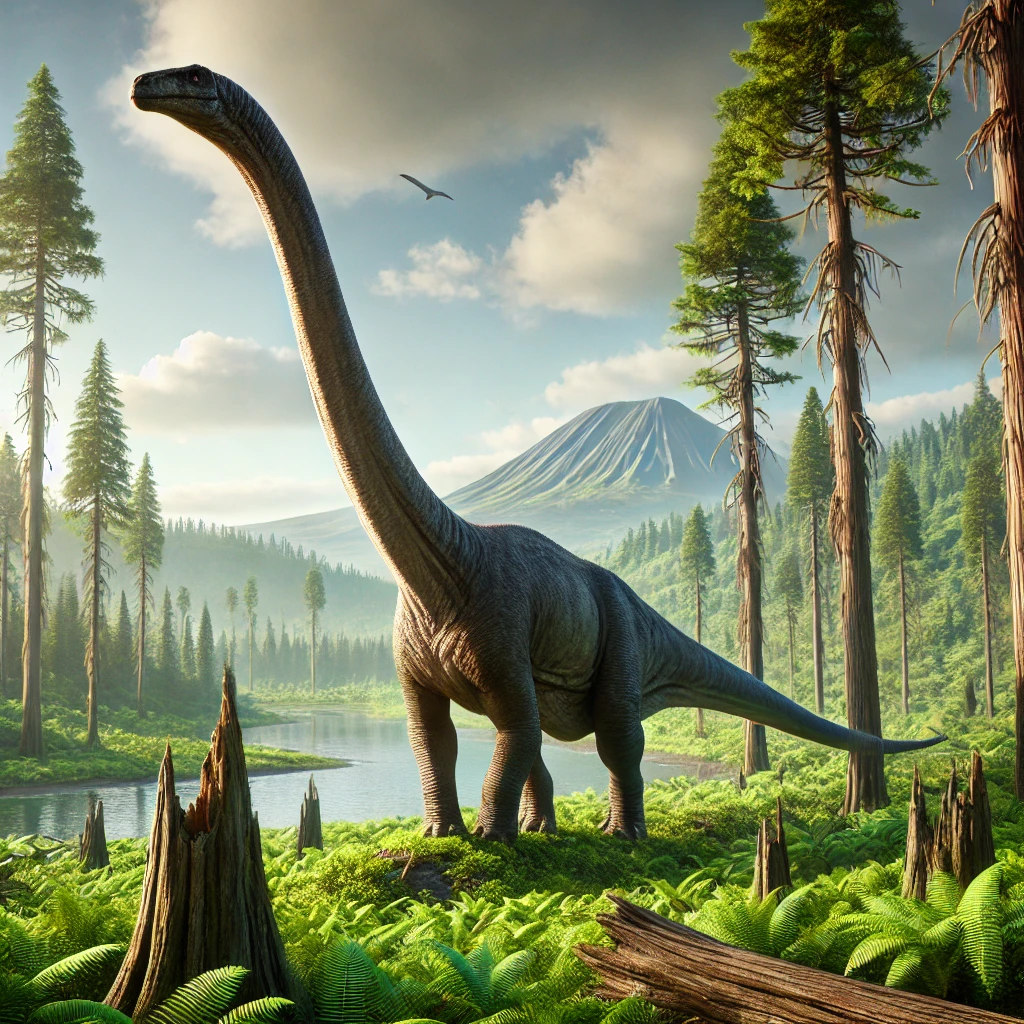Giraffatitan
Pronunciation:
Ji-raf-ah-tie-tan
Name Meaning:
“Titanic giraffe”
Dinosaur Classification:
- Kingdom: Animalia
- Phylum: Chordata
- Class: Reptilia
- Order: Saurischia
- Suborder: Sauropodomorpha
- Family: Brachiosauridae
- Genus: Giraffatitan
- Species: G. brancai
Dinosaur Description:
Giraffatitan, known for its towering stature, is one of the most impressive sauropod dinosaurs ever discovered. It lived during the Late Jurassic period, about 150 million years ago, and roamed the ancient floodplains of what is now Africa. Originally classified as a species of Brachiosaurus, further study revealed that it deserved its own genus, Giraffatitan, because of distinct skeletal features.
Standing at nearly 40 feet (12 meters) tall and stretching up to 85 feet (26 meters) in length, Giraffatitan was a giant among dinosaurs. Its long neck, which gave it a giraffe-like appearance, allowed it to feed on the tallest trees, something few other herbivores could do. This ability likely helped it avoid competition for food from other large herbivores. Its front legs were longer than its back legs, giving it an upright posture and further enhancing its ability to reach higher vegetation.
The enormous size of Giraffatitan required it to consume massive quantities of plant matter to sustain itself. It likely fed on conifers, cycads, and ferns, using its peg-like teeth to strip leaves off branches. Despite its immense size, Giraffatitan’s brain was relatively small, housed in a skull that was notably light due to large air spaces, a feature that reduced the overall weight of its neck and head.
Giraffatitan’s build was well-suited for long periods of browsing at great heights. While its size protected it from most predators, it likely needed to stay in areas with abundant vegetation to maintain its high energy needs. Unlike many other dinosaurs, Giraffatitan did not rely on herds for protection; its size alone was a sufficient deterrent against predators.
Dinosaur Diet and Behavior:
Giraffatitan was a herbivore, primarily feeding on the leaves of tall trees such as conifers and ginkgos. Its long neck and upright posture allowed it to reach heights that were inaccessible to most other herbivores. Due to its massive size, Giraffatitan likely spent much of its day grazing to meet its dietary needs. Its teeth were designed for stripping vegetation, not chewing, so plant material would have been swallowed whole and digested slowly in its large gut.
Dinosaur Size:
Giraffatitan stood around 40 feet (12 meters) tall and measured approximately 85 feet (26 meters) in length, making it one of the tallest and largest dinosaurs ever discovered.
Dinosaur Weight:
Giraffatitan is estimated to have weighed between 30 to 60 tons (60,000 to 120,000 pounds), depending on the specific specimen.
Fossil Discoveries:
Giraffatitan fossils were first discovered in the Tendaguru Formation in Tanzania in the early 20th century. The remains were part of a German-led expedition, and much of the original material was shipped back to Germany for study. The holotype specimen of Giraffatitan is one of the most complete sauropod skeletons ever found, and it has provided scientists with invaluable insight into the anatomy and behavior of these enormous creatures. Initially classified as Brachiosaurus brancai, it was later reclassified into its own genus in the late 20th century due to differences in bone structure and proportions.
What Period Did The Dinosaur Live:
Giraffatitan lived during the Late Jurassic period, around 150 million years ago.
Notable Facts or Trivia:
– Giraffatitan was originally thought to be a species of Brachiosaurus but was later reclassified as a separate genus.
– Its long neck and giraffe-like appearance inspired its name, meaning “titanic giraffe.”
– Giraffatitan’s skull was remarkably light due to large air spaces, reducing the strain on its long neck.
– It is one of the tallest dinosaurs ever discovered.
Scientific Significance:
The discovery and classification of Giraffatitan have had a profound impact on our understanding of sauropod evolution, particularly in Africa. Its separation from Brachiosaurus highlighted the diversity of large sauropods in different regions. Giraffatitan’s adaptations for browsing at extreme heights demonstrate the incredible variety of niches these dinosaurs filled during the Jurassic period. Its fossils have also helped paleontologists understand the structural adaptations required for such large animals to move and feed efficiently.
Extinction & Legacy:
Giraffatitan, like many other large dinosaurs, went extinct at the end of the Jurassic period. However, its well-preserved fossils have left a lasting legacy in paleontology, offering insights into the life of the largest land animals ever to roam the Earth. Today, Giraffatitan is remembered as one of the most awe-inspiring sauropods, with its towering presence capturing the imaginations of scientists and dinosaur enthusiasts alike.
